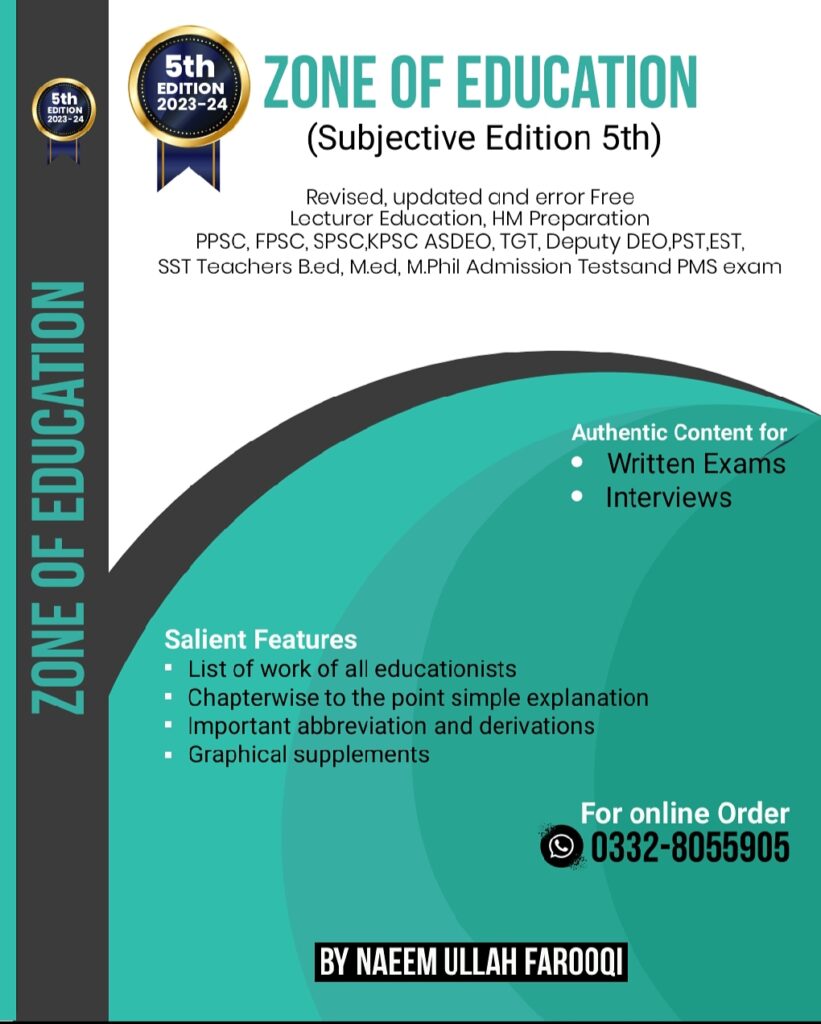Assessment.
171. The value that divides the data into two equal parts is called:
A. Mean
B. Median
C. Mode
D. None
Ans: B. Median
172. “Table of Specification” helps in ensuring:
A. Validity
B. Reliability
C. Fairness
D. None
Ans: A. Validity
173. Another name for the “Table of Specification” is:
A. Test Blue Print
B. Test Construct
C. Test Reliability
D. None
Ans: A. Test Blue Print
174. In a multiple-choice item, the statement composed of a question is referred to as:
A. Distracter
B. Answer
C. Stem
D. Response
Ans: C. Stem
175. In Multiple Choice Questions, the stem of the items should be:
A. Simple
B. Meaningful
C. Small
D. None
Ans: B. Meaningful
176. In item analysis, the Facility Index of an item tells:
A. Objectivity level
B. Reliability level
C. Difficulty level
D. None
Ans: C. Difficulty level
177. The Facility Index of an item is a concept related to:
A. Item Analysis
B. Table of Specification
C. SLO
D. None
Ans: A. Item Analysis
178. A test item is generally considered acceptable if its Facility Index ranges from:
A. 0.30-0.70
B. 0.70-0.80
C. 0.10-0.30
D. None
Ans: A. 0.30-0.70
179. A test item is considered very easy when its Facility Index is higher than:
A. 30-70%
B. 70%
C. 30%
D. None
Ans: B. 70%
180. A test item is considered very difficult when its Facility Index is lower than:
A. 30-70%
B. 70%
C. 30%
D. None
Ans: C. 30%
181. In item analysis, which of the following measures is applied to sort high and low-level achievers?
A. Facility Index
B. Discrimination Index
C. Standard Deviation
D. None
Ans: B. Discrimination Index
182. Which of the following represents “running description of active behavior of a student as observed by the teacher”?
A. Viva voce
B. Anecdotal record
C. Interview
D. None
Ans: B. Anecdotal record
183. The extent to which an evaluation is truthful or valid in what it says about a program, project, or material is termed as:
A. Accuracy
B. Bias
C. Validity
D. None of the above
Ans: A. Accuracy
184. Achievement in a test is actually the:
A. Progress
B. Performance
C. Failure
D. None of the above
Ans: B. Performance
185. The domain of Bloom’s taxonomy which consists of emotions, feelings, and attitudes is termed as:
A. Cognitive Domain
B. Affective Domain
C. Psychomotor Domain
D. None of the above
Ans: B. Affective Domain
186. Loss of subjects from the defined sample during the course of data collection is called:
A. Arbitration
B. Attrition
C. Attraction
D. None of the above
Ans: B. Attrition
187. The consumers of the evaluation; those who will or should read or hear of the evaluation is called:
A. Customers
B. Buyers
C. End users
D. Audience
Ans: D. Audience
188. Authentic assessment focuses on student skills in carrying out:
A. Mock exercises
B. Demonstrations
C. Real-world tasks
D. None of the above
Ans: C. Real-world tasks
189. Facts about the condition or performance of subjects prior to treatment or intervention is termed as:
A. Behaviour data
B. Baseline data
C. Actual data
D. All of the above
Ans: B. Baseline data
190. A scale that distinguishes among individuals by putting them into a limited number of groups or categories is called:
A. Categorical scale
B. Behavioural scale
C. Actual scale
D. Multiple scale
Ans: A. Categorical scale
191. The checklist approach is the principal instrument for practical evaluation, especially for investigating the:
A. Intensity of implementation
B. Thoroughness of implementation
C. Depth of implementation
D. All of the above
Ans: D. All of the above
192. A term used to designate one group among many in a study is:
A. Cobalt
B. Coherence
C. Cohort
D. Category
Ans: C. Cohort
193. ______ is a set of concepts that generate hypotheses and simplify description, through the classification and categorization of phenomena, and the identification of relationships among them.
A. Conceptual scheme
B. Practical scheme
C. Analytical scheme
D. None of the above
Ans: A. Conceptual scheme
194. A measuring scale containing a large, perhaps infinite, number of intervals is called:
A. Long scale
B. Continuous scale
C. Multiple scale
D. None of the above
Ans: B. Continuous scale
195. Units on a continuous scale do not have a:
A. Maximum size
B. Minimum size
C. Average size
D. Both A & B
Ans: D. Both A & B
196. Employing graded assignments from across the curriculum as direct measures of student learning is termed as:
A. Course-Embedded Assessment
B. Course-Guided Assessment
C. Course-overall Assessment
D. None of the above
Ans: A. Course-Embedded Assessment
197. Cross-sectional study is a:
A. Schematic sample
B. Random sample
C. Stratified sample
D. None of the above
Ans: B. Random sample
198. Successive cross-sectional studies can be used as a substitute for a:
A. Longitudinal study
B. Horizontal study
C. Actual study
D. None of the above
Ans: A. Longitudinal study
199. The process of stipulating the investigatory procedures to be followed in doing a specific evaluation is known as:
A. Format
B. Design
C. Layout
D. None of the above
Ans: B. Design
200. The worth of a project in achieving formative or summative objectives is called:
A. Efficiency
B. Credibility
C. Authenticity
D. Effectiveness
Ans: D. Effectiveness
JOIN ZONE OF EDUCATIONPK!
Discover the most comprehensive and reliable pedagogy resources in Pakistan, curated for competitive exam success. Our content covers all competitive exam MCQs, including PPSC, FPSC, AJKPSC, SPSC, and more. Designed to empower learners with top-notch material and insights, trust us for your preparation journey!


